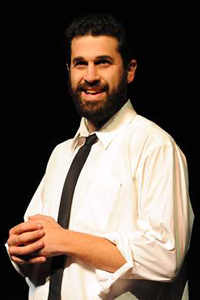In this three-part guest blog series, the creators of This Sweaty City, a project by Goat in the Road Productions, talk about the origins of this original, New Orleans-based 12-part performance/podcast series that began in May. In this article, Chris Kaminstein explores the way in which This Sweaty City took a page from magical realism author Jorge Luis Borges in trying to capture the essence of New Orleans. Click here to read other installments in the series.

Chris Kaminstein
In The Argentine Writer and Tradition, Jorge Luis Borges talks about his initial frustrations in trying to convey his home, Buenos Aires, through story. As a young author he wanted to capture the city, so he copied down its flavor, using local words and local color, the names of local places, etc. But the work fell flat; his audience didn’t feel he was revealing the city as they knew it. The stories didn’t portray Buenos Aires; they instead showed someone trying to portray Buenos Aires.
Then he tells us this: “Then, about a year ago, I wrote a story called ‘Death and the Compass’ which is a kind of nightmare, a nightmare in which there are elements of Buenos Aires.” And, later, “Precisely because I had not set out to find that flavor, because I had abandoned myself to a dream, I was able to accomplish, after so many years, what I had previously sought in vain.”
The phrase that sticks with me is “abandoned myself to a dream.” Borges had stopped trying to display his home to the world (to prove to everyone that the home was his), and instead wrote immersed in it. His stories were now about another city, like his city, but not his city. Through this one degree of removal he could write honestly about his home.
For This Sweaty City, the radioplay produced by Goat in the Road that you’ve been hearing about in the pages of Nolavie over the last couple weeks, we used this Borges’ model and made equivalences. We thought of our city and the things we love, then we made a magical/absurdist version of them. So…
| Real World | This Sweaty City World |
| Political inefficiency | Bureaucratic offices operate on always-moving, inaccessible steamboats |
| Double Decker Bikes | Bikes operate independently of humans and travel in packs |
| Middle Aged Alcoholics | Pan, the Goat God of Wine |
| Mardi Gras | The water-laden city, which slowly separates into floating sections each year like a starfish, sews itself back together with a giant party and celebration |
| Barber Shop | Barry Shop |
| Parades | Traveling troupes of Players who put on surprise stage dramas |
Actually, for your listening pleasure, here’s a clip of the ‘bike-fight’ from episode 2 in the show. In it, you’ll hear the main character Peter trying to escape from a rogue band of bicycles bent on violence.
Borges’ essay is a primer on magical realism by the author who started it all; it’s an explanation of the usefulness of fiction, it’s a defense of art, yes and yes and yes.
But it’s also a useful guide for citizenship. For the first couple of years in New Orleans, Goat in the Road didn’t write about the city. We were newcomers, wary of our status as outsiders, careful about what we wanted to say. But this project, and its one degree of removal, has allowed us to struggle with the beauty and the darkness that are a part of New Orleans.
Lightness and darkness, drunkenness and sobriety, hospitality and violence, community beauty and deeply ingrained racism. These issues develop and exist in tandem, intertwined and difficult to navigate. It’s easy for us to be tour guides in this city (Crawfish! To-go cups! Brass bands!), but I think the harder thing is to be part of the problem. Not looking at the problem, but entwined in it, mixed up in it, willing to listen and push and question as a citizen.
There are some amazing artists and writers doing that right now, struggling with the bright and dark of New Orleans, and my hope for Goat in the Road is that we might emulate them; to live in this our adopted city not as tourists, but as citizens.
 NOLAbeings Multimedia artist Claire Bangser created NOLAbeings as a portrait-based story project that marries...
NOLAbeings Multimedia artist Claire Bangser created NOLAbeings as a portrait-based story project that marries...  Voodoo in New Orleans: Reviving history: New Orleans fortune telling This article takes a deep dive into the history of Voodoo in New Orleans, its hybridization with Catholicism, and its present-day place in the city's culture. The author visits fortune-tellers in the French Quarter, using their guidance as a tool for introspection rather than a deterministic predictor of the future. Through her experiences in New Orleans, the author feels a mystical connection to both the past and the future.
Voodoo in New Orleans: Reviving history: New Orleans fortune telling This article takes a deep dive into the history of Voodoo in New Orleans, its hybridization with Catholicism, and its present-day place in the city's culture. The author visits fortune-tellers in the French Quarter, using their guidance as a tool for introspection rather than a deterministic predictor of the future. Through her experiences in New Orleans, the author feels a mystical connection to both the past and the future. 